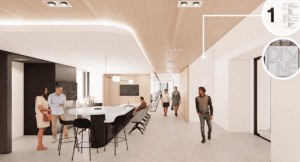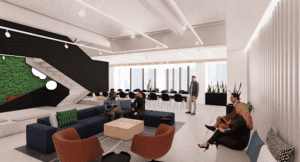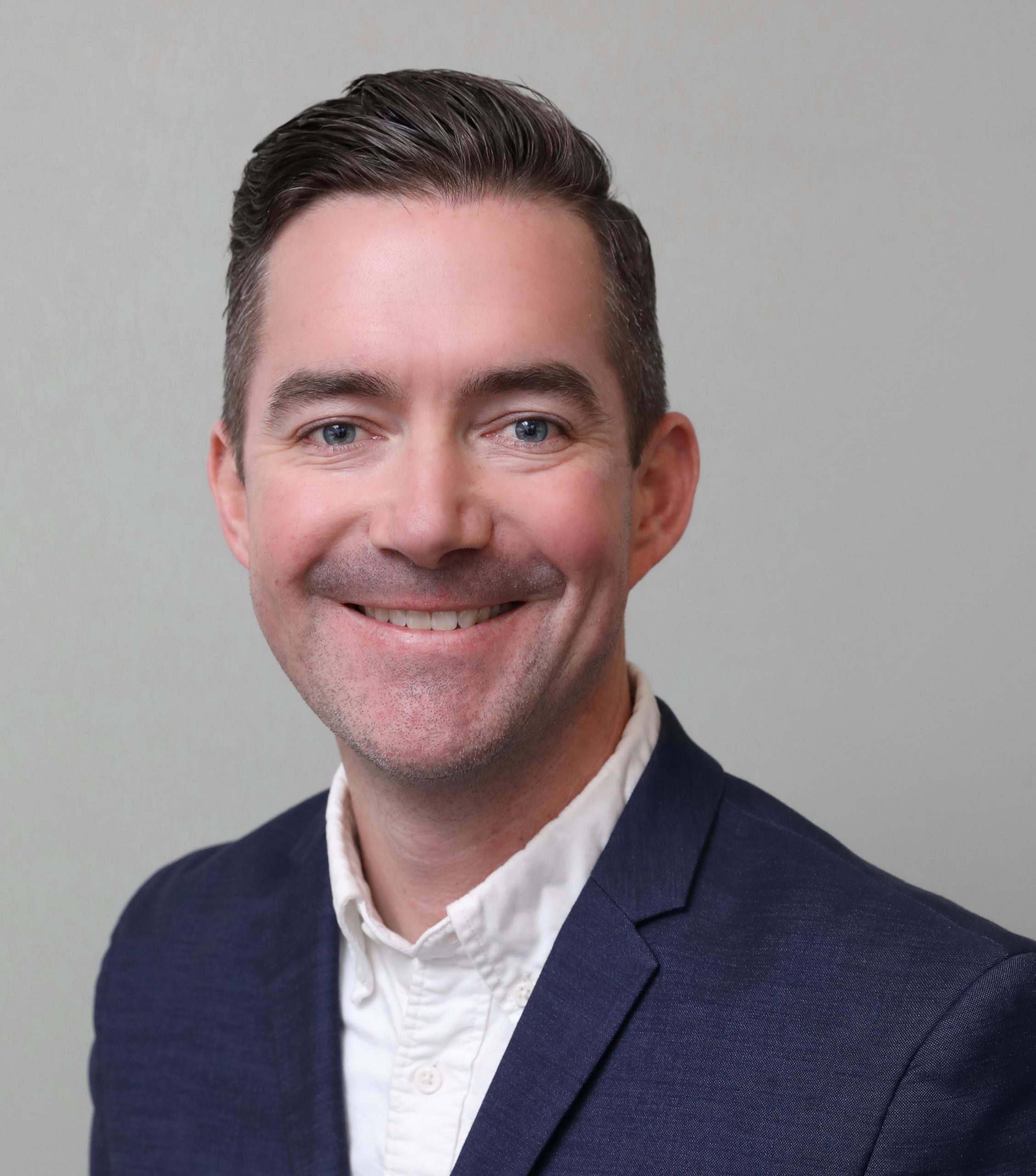Overlooking “the crossroads of the world,” Times Square, Schrödinger’s new New York City office—occupying four floors of 1540 Broadway—is a reprieve from the hustle and provides a haven of wellness and sustainability.
The new workplace brought together a collaboration of stakeholders from Schrödinger’s leadership team and architecture firm HLW, including HLW’s internal sustainability consultancy, BEYOND, to develop a workplace that prioritizes health, wellbeing, and the environment equally. The multidisciplinary team set ambitious goals for both creativity and performance, pursuing three different rating systems—LEED v4 ID+C Gold, Fitwel 2 Stars, and WELL Health-Safety—to solidify Schrödinger’s commitment to promoting an inspirational and ecologically-conscious workplace culture.

From a performance perspective, the primary focus for Schrödinger’s new office was decarbonization—specifically reducing embodied carbon emissions, the carbon dioxide emissions associated with materials and construction processes, as much as possible. Office spaces are notorious for their short life cycles, becoming increasingly resource-intensive as new residents completely redesign spaces through constant turnover. On average, interior spaces are renovated around seven to eight times in the life cycle of a building, accumulating into a massive embodied carbon usage by the end of a building’s life. Many companies today handle carbon emissions by offsetting them, making up for emitting carbon in one area by planting trees in another, for example. Unfortunately, offsets aren’t enough; industries, and particularly real estate, need to reduce the emissions on the front end.
By taking sustainability into account from the onset, the strategy and design for Schrödinger’s new office emits 55% less carbon than the construction industry average, which is responsible for 40% of all global carbon emissions. This reduction in footprint also surpasses the benchmarks set by the American Institute of Architect’s 2030 Challenge—which seeks to bring the built environment to net zero emissions in the next eight years. To achieve this cutting-edge sustainable performance for Schrödinger’s new office space, HLW and the BEYOND team carefully examined every partition, ceiling system, carpeting, and all other materials entering the building, measuring their carbon footprint to ensure the most sustainable option was utilized throughout the course of the project. Further, the BEYOND team worked to incorporate as many materials as possible that had a “Healthy Product Declaration,” which acts as a nutrition label for the item, such as carpeting or ceiling tiles. The declaration lists everything that went into making the item, down to the chemistry, to ensure it was sustainably sourced.

Every inch of the workplace raises the bar in reducing carbon while maximizing wellness. More than just a formulaic approach, however, the HLW team sought inventive, performant alternatives to traditional materials to exemplify this mission. This exercise helped the space meet the LEED v4 ID+C certification, while keeping sustainability in mind when addressing energy, water, and other forms of waste in the design process. These various programs communicated both to Schrödinger’s staff, stakeholders, and clients that the company remained conscious of its footprint throughout the entire process.
It was also important for Schrödinger’s new office to be as healthy for the people within it as it is for the environment that surrounds it, which led to the pursuit of both Fitwel Certification and Well Health-Safety Rated. Fitwel—which requires that rated spaces integrate the best strategies that science has to offer to optimize and improve health—serves as a signal to Schrödinger’s staff, stakeholders, and clients that wellness has a key role in the design, development, and day-to-day operations of its workplace. Taking the priorities of health and wellbeing one step further, Well Health-Safety focuses on operation policies, maintenance protocols, stakeholder engagement and emergency plans to keep employees safe and was developed in direct response to the COVID-19 pandemic.
Every inch of the workplace raises the bar in reducing carbon while maximizing wellness.
To achieve the standards set by these programs, the office layout was carefully planned to encourage movement while ensuring a safe distance could be maintained between desks as per health and safety guidelines for the current New York City environment. For example, centrally located staircases were marked with step counts, providing a playful way for employees to measure the exercise they are getting by using the stairs rather than the elevator. Connection to nature was also promoted throughout, with curated biophilic moments and sweeping views to the outdoors—with some windows featuring clever decals that articulate the air quality outside at that height. Signage and graphics, while fun and creative, were also inherently inclusive at heart —aimed at fostering an equitable workplace environment to further support employee wellbeing. For the restrooms, for example, pictures depicting the equipment in each room are displayed, rather than referencing sex or gender, helping to acknowledge different experiences and identities.
The resulting space—the product of a true collaboration between HLW, BEYOND, and of the Schrödinger team—is wholly unique, hallmarked by a primary focus on sustainability and making as little an environmental impact as possible, while also being covered in functional, intelligent design elements for a workplace that is fun and familiar.










